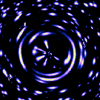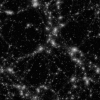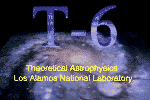

Objective and Approach: The primary astrophysical objectives of our project are (1) understanding of structure formation on sub-galactic to cosmological distance scales (looking for the imprints of the cosmological parameters and initial conditions that can be decoded from current observations) and (2) study of accretion problems such as stellar collisions, disruptions, and accretion onto a black hole. The primary computational objective is the development of scalable parallel hierarchical N-body/SPH (Smoothed Particle Hydrodynamic) and hybrid codes suitable for addressing these problems. The computational methods will be adapted for other astrophysical problems and eventually applied to problems in other disciplines.
Accomplishments: We have simulated the formation of galaxies in several cosmological models with unprecedented resolution and have shown that the Cold Dark Matter model is compatible with some of the constraints that were previously thought to rule it out. We have also modeled tidal disruption of a star passing near a black hole, which has shed new light on the astrophysics of quasars. This model was accomplished by implementing our N-body tree code and SPH algorithm on a variety of machines, including the Intel Paragon, IBM SP-2, Thinking Machines Corp. CM-5, and CRAY T3D. We have obtained performance in the neighborhood of 10 GFLOPS on all of these machines.
Significance: The general applicability of our code to a wide range of problems makes it attractive for use in other areas. For instance, we have also extended the use of tree codes to panel methods for the computation of potential flow aerodynamics, successfully computing flows over surfaces with 1 million panels. This demonstrates a definite interdisciplinary link to NASA's Computational Aerosciences (CAS) project. We also have begun a collaboration with an industrial partner who is interested in the application of these methods to electromagnetic scattering problems. Essential to the transition to parallel computing is the existence of adaptable codes that will parallelize a variety of applications so that users only need to specify the "physics'' of a problem and not the details of data structures, load balancing, and interprocessor communication. The codes we are developing have made strong progress toward that goal.
Status/Plans: We continue to improve the usability of the tree code library through refinement of the user interface. The overall performance of the code will be further improved by careful attention to memory use and storage issues, enabling simulations with 100 million particles to occur within the near future.
 Comparison of Four Popular Cosmological Models (264 Kbytes)
Comparison of Four Popular Cosmological Models (264 Kbytes)
 Animation of a 16.7 Million Particle Simulation. (5.5 Mbytes)
Animation of a 16.7 Million Particle Simulation. (5.5 Mbytes)
Point of Contact:
Dr. Wojciech H. Zurek
Los Alamos National Laboratory
whz@lanl.gov
505-667-6837
 LANL Theoretical Astrophysics Home Page.
LANL Theoretical Astrophysics Home Page.